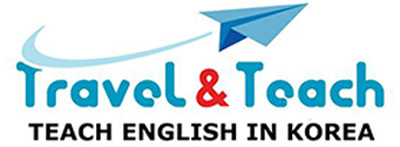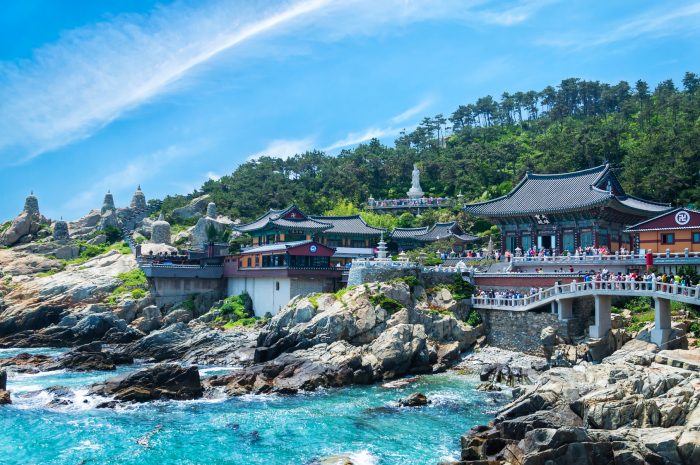Thinking about teaching English in Busan?
Are you thinking about teaching English in Busan? Busan, also spelled Pusan, is South Korea’s largest port city and Korea’s second largest metropolitan city with a population of around 3.6 million. It is located on the south-eastern most tip of the Korean peninsula; it resides on the East Sea and is known for its famous – and usually crowded – beaches.
Busan is called the summer capital of Korea because it attracts tourists from all over the country. It has luxurious hotels and a great boardwalk near the beach. Its two most popular beaches are Haeundae Beach and Gwangalli Beach. These areas are known for their boardwalk, hotels, cafes, bars and restaurants. The university districts are also popular for such attractions.
Busan is home of the Lotte Giants baseball team, who is known for having some of the more enthusiastic fans in Korea. The city is also the home of Busan I’Park soccer team and has a basketball team by the name of the KTF Magic Wings.
Landmarks in Busan
Pusan National University (PNU): One of the most recognized national institutes for higher education in all of Korea. The university area is a great place for entertainment and nightlife.
Taejongdae: A Natural Park with magnificent cliffs, facing Yeongdo.
Foreigners’ Shopping Street: Commonly referred to as “Texas Street”, where businesses cater to the local Russian population and foreign ship crew members
Busan Aquarium: First opening in 2001, this $30 million facility has thousands of tropical fish along with sharks and stingrays.
Haeundae Beach and Gwangalli Beach: The two most popular beaches in Busan, and possibly in all of Korea.
Dongnae-gu: A wealthy and traditional residential area. Well known for its natural spa area, many baths, tourist hotels, restaurants, clubs and shopping areas. Many restaurants in the area are famous for their family recipes.
Geumjeongsan: A great hiking opportunity right in the city of Busan. Thousands of people climb this mountain every weekend, making it the most popular hiking destination in all of Busan.
Temples and Fortresses in Busan
Chungnyeolsa Shrine: A shrine dedicated to the fighters that died while trying to resist the invasion of the Japanese in 1592-98.
Beomeosa Temple: The city’s main Korean Buddhist temple.
Samgwangsa Temple: One of the most treasured Buddhist temples in Busan, it is located in the thick forest of BaekYang Mountain and offers a unique view of the sunrise and of the city.
Haedongyonggungsa Temple: Built into the rock cliffs overlooking the ocean, this temple offers a beautiful view of the water. Make sure to climb up the stairs behind the temple but be cautious as it can be slippery and a little steep. Best to go on a sunny day.
Geumjeongsanseong: Meaning ‘Geungjeong Mountain Fortress’, this is the largest mountain fortress in Korea today. After invasions from Japan and China, the fortress was constructed as a means to defend against further attacks from the sea.
Fortress site of Jwasuyeong: The site of the fortress of the Gyeongsangjwado naval forces in the Joseon period. At one time there were 65 battle ships and seven naval ports under its command.
Yonggungsa Temple: Rebuilt in the 1930s, this temple is situated on the cliffs overlooking the sea and is surrounded by a circle of pine trees.
Busanjinjiseong (Jaseongdae): Constructed by the Japanese during their invasion of Korea (1592-98).
Museums in Busan
Busan Museum: Built for the purpose of preserving the culture and history of Busan. Hours are from 9am-6pm (Mar-Oct) and 9am-5pm (Nov-Feb) and is closed on Mondays.
Bokcheon Museum: Offers 150 pieces of Korean art, 200 pieces of Chinese art and over 2500 documents from the Joseon Dynasty. Hours are 11am-6pm Tues-Sun.
Busan Museum of Modern Art: Built with the idea of educating the public on art and culture. Hours are from 10am-6pm.
Dongsam-dong Shell Midden Museum: Find displays of pottery, stone and bone tools. The exhibitions display the lifestyle and culture of the Neolithic people of 7,500 to 3,500 years ago. Hours are from 9am-6pm (Mar-Oct) and 9am-5pm (Nov-Feb).
Festivals in Busan
Fireworks Festival: This festival has grown into one of the largest fireworks shows in Busan and is watched by over 1.3 million people each year. Usually occurring at the end of October at both Gwangalli and Gwangan Bridge. This is an event that you should not miss if you are teaching English in Busan.
Busan (Pusan) International Film Festival. Is one of the most important film festivals in all of Asia. The main purpose of the PIFF is to introduce new films and first time directors. The PIFF usually takes place in either September of October each year.
Nightlife in Busan
Champion This: A trendy nightclub in the Semyeon area for those teaching English in Busan. Having a 500 person capacity, table service is offered in addition to live Korean cabaret and a huge dance floor.
Crossroads: A great indie rock nightclub located in the Jangjeon-dong area of Busan. Crossroads also offers live performances of some famous Korean bands. Also be sure to check out ‘The Art Bar’, located in the same building.
The Basement: More of a funky nightclub and a favorite among foreigners, it is located in same building as the ‘Crossroads’ in the Pusan National University area. Complete with a great drink menu, The Basement offers great hip-hop and R&B.
The Vinyl: If you are looking for more of an intimate nightclub, The Vinyl is the place for you. Offering great wine, strong cocktails and late hours, this is a great destination for expats.
Transportation in Busan
If you are teaching English in Busan, the best way to get around town is by subway. The Busan subway system consists of 4 lines serving 107 stations.
If you want to get away for a weekend, you can get to almost anywhere in Korea by bus. There are two major bus terminals: Nopodong Bus Terminal (at the northern terminus of Subway Line 1) and Seobu Bus Terminal (at Sasang Station on Subway Line 2).
If you are teaching in Busan and want to take a trip to Geoje Island and Jeju Do, you can use the Busan Coastal Ferry Terminal. If travelling to Japan, the Busan International Ferry Terminal connects to Japanese ports such as Izuhara and Hitakatsu on Tsushima Island, as well as the cities of Shimonoseki, Fukuoka, and Osaka on Japan’s mainland.
If you want to go by air, Busan’s International Airport, Gimhae International Airport will fly to most international countries with a possible stopover at the airport in Incheon.


